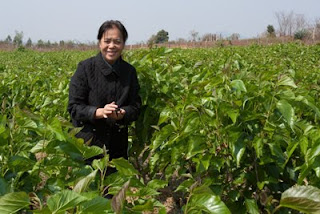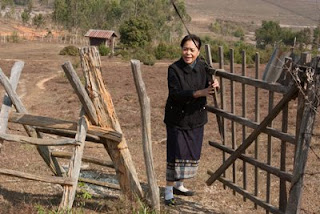Text and photos by Ellen Agger
___________________________________________
As we drive into Nawn Thoong village in Thailand’s northeast province of Khon Kaen, Pii Yai is excited. She has served for many years on the board of directors of Prae Pan Group, a women’s weaving co-operative in Thailand’s northeast, whose staff set up our visits today to three villages where members live and work.
 We gather across the street at the house of Mae Pit, a long-time Prae Pan member. She and the four other members sit on a mat next to the house, protected from the glaring sun. They’re in their late 50s. These are the silk weavers in the village. Like most of Prae Pan’s members, they are farmers who fit weaving around their farming chores and care for their children, grandchildren and elders. Weaving brings in much needed additional income, used to send their children to trade school or university, for health care and to improve their lives in the village.
We gather across the street at the house of Mae Pit, a long-time Prae Pan member. She and the four other members sit on a mat next to the house, protected from the glaring sun. They’re in their late 50s. These are the silk weavers in the village. Like most of Prae Pan’s members, they are farmers who fit weaving around their farming chores and care for their children, grandchildren and elders. Weaving brings in much needed additional income, used to send their children to trade school or university, for health care and to improve their lives in the village.By belonging to the co-op they are paid for their work as soon as they deliver it to the group’s shop in Khon Kaen city. Members are proud that the co-op owns this shop, reflecting the group’s goal of being self-sufficient.
 Co-op membership gives members the chance to work with customers like TAMMACHAT Natural Textiles which pays 50% in advance for orders. “On our annual visits with groups like Prae Pan, we deepen our relationships,” says TAMMACHAT co-founder Alleson Kase. “This year we are learning more about the group’s capacity to weave organic, naturally dyed silk fabric for the growing eco-textile market. We have also started to collaborate on designing bags for the North American market.”
Co-op membership gives members the chance to work with customers like TAMMACHAT Natural Textiles which pays 50% in advance for orders. “On our annual visits with groups like Prae Pan, we deepen our relationships,” says TAMMACHAT co-founder Alleson Kase. “This year we are learning more about the group’s capacity to weave organic, naturally dyed silk fabric for the growing eco-textile market. We have also started to collaborate on designing bags for the North American market.” Co-op membership has also given members a market for their weaving well beyond what they would otherwise be able to reach as individuals. They are keen to learn more about the markets in our country, as they don’t often have the chance to meet directly with foreign customers of the co-op.
Co-op membership has also given members a market for their weaving well beyond what they would otherwise be able to reach as individuals. They are keen to learn more about the markets in our country, as they don’t often have the chance to meet directly with foreign customers of the co-op.We ask the women gathered today if they are passing on their skills, learned from their mothers. Now their daughters are going off to earn their livings in the cities or on to further schooling. These skills are at risk of being lost, we’re told again and again on visits like these.
Sometimes younger women do return to their village when their children are small, preferring a quieter life where they have family support networks. “When I was young,” says one of the women, “I went away to work in a factory. Then I came back to my village. At home, you’re free. I can farm and I’m happier.”
 After choosing samples of silk yarns of some of the colours they can produce in this village, we thank the women, jump in Pii Yai’s truck and arrive a short time later in Nom Thoom village. We stop at the house of Mae Nung who is feeding organic mulberry leaves to heritage silkworms in baskets her husband has woven. She sits behind blue netting that protects the sensitive silkworms from exposure to diseases and chemicals like cigarette smoke. “Raising silkworms is like raising babies,” she says. The resulting silk yarns, painstakingly reeled by hand, are produced organically, we learn, protecting both the women’s health and their local environment.
After choosing samples of silk yarns of some of the colours they can produce in this village, we thank the women, jump in Pii Yai’s truck and arrive a short time later in Nom Thoom village. We stop at the house of Mae Nung who is feeding organic mulberry leaves to heritage silkworms in baskets her husband has woven. She sits behind blue netting that protects the sensitive silkworms from exposure to diseases and chemicals like cigarette smoke. “Raising silkworms is like raising babies,” she says. The resulting silk yarns, painstakingly reeled by hand, are produced organically, we learn, protecting both the women’s health and their local environment.We meet with 10 women, ranging in age from mid-forties to over 70. For all the women, this work brings income to the family. For some, it’s more. “If I don’t weave,” says Mae Som, age 49, “I cannot sleep.” Mae Tong Luan tells us, “It’s important to me that I do the whole cycle of production. It’s a circle.”
 In neighbouring Suk Som Boon village, Mae Nung practices this full circle. She grows the mulberry bushes to feed the silkworms, hand reels and twists silk yarns, dyes them with natural dyes that she has grown or gathered in the wild, and weaves. It’s time consuming work. It takes 2 months to produce 12 handwoven, naturally dyed silk scarves, 3 months to produce 40 metres of organic silk fabric.
In neighbouring Suk Som Boon village, Mae Nung practices this full circle. She grows the mulberry bushes to feed the silkworms, hand reels and twists silk yarns, dyes them with natural dyes that she has grown or gathered in the wild, and weaves. It’s time consuming work. It takes 2 months to produce 12 handwoven, naturally dyed silk scarves, 3 months to produce 40 metres of organic silk fabric.
We watch as Mae Pan cuts the reddish green leaves of “maak yao.” She has a new recipe to create a luminescent green. She dips the silk yarns in the simmering dye bath twice, then gets help from Mae Pet, the president of Prae Pan, to straighten the fine yarns and then they hang them to dry.
Preserving these traditional skills – and bringing income to women in Thailand and Laos’s rural areas – is what’s behind TAMMACHAT’s work. “Fair trade is about much more than paying fairly for the work,” says Alleson. “It’s about respecting the people who do the work, learning from each other and supporting sustainable practices. It makes a real difference in the lives of these women,” she adds.
“Our weavers are very proud when they can weave cloth beautiful enough to attract customers,” Mae Pet tells us. And well they should be.
For more info, visit TAMMACHAT Natural Textiles and Prae Pan Group.





















